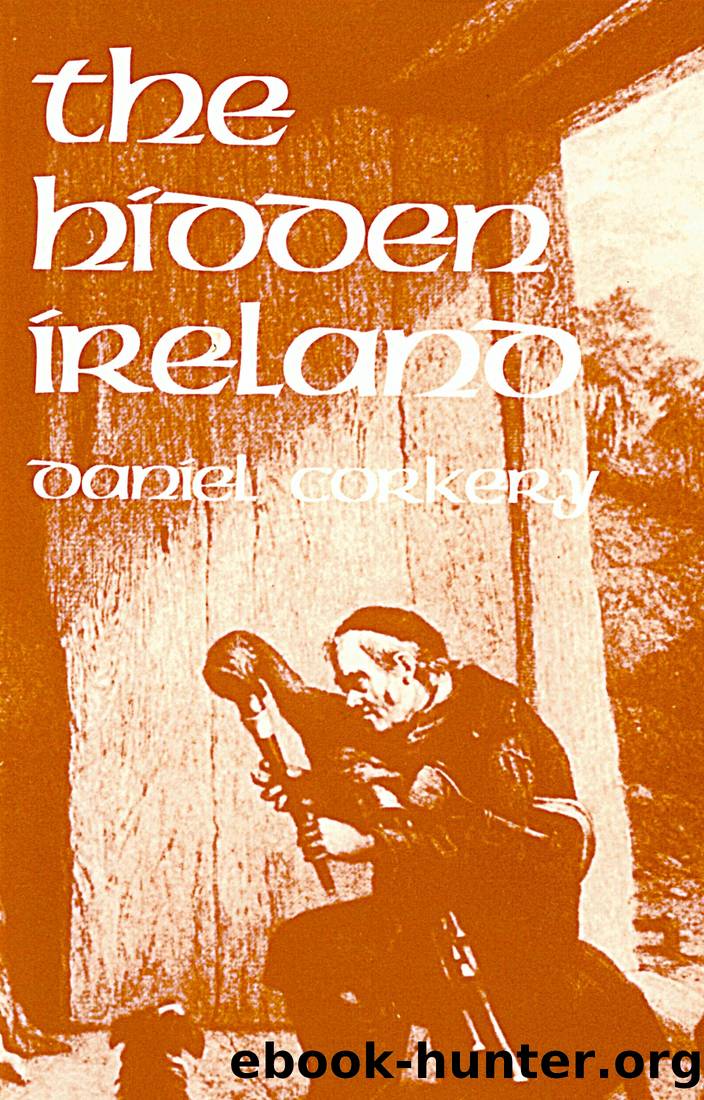The Hidden Ireland â A Study of Gaelic Munster in the Eighteenth Century by Daniel Corkery

Author:Daniel Corkery [Corkery, Daniel]
Language: eng
Format: epub
Tags: 2AFR, DSBF, D, LIT004120, 1DBR, HIS018000, DS, POE005020, DSC, HIS010020, HIS037050, DC, LIT014000, HBLL, HIS010000, LIT000000, HBJD1
ISBN: 9780717165766
Publisher: Gill
Published: 2015-06-25T05:00:00+00:00
Chapter 2: The Big House
I
Irish Ireland had become in the eighteenth century a peasant nation, harried and poverty-stricken, with the cottierâs smoky cabin for stronghold. But this does not mean that there were no longer any Big Houses, as we may call them, nor well-to-do families in these Gaelic-speaking countrysides. Both the stories of the poetsâ lives and the songs they have left us save us from such an idea. Froude tells us that nine-tenths of the land was in 1703 held by Protestants of English or Scotch extraction, an estimate that is probably correct; yet here and there, and especially in Munster, certain big Gaelic Houses had escaped destruction; and only for they had, the story of Irish literature in that century would be very different from what it is, as gradually we shall come to realise.
Through sheer luck, it might be said, these houses had come to survive. They represented hardly ever the main branch of any of the historic families; they were rather the minor branches, far-removed, and not too well known to the authorities in Dublin. Those city-bred, sometimes English-bred, lawyers and statesmen had often only shadowy ideas of the boundaries of the lands they were confiscating. They were not quite sure when their work was done, either in seizing a property or re-parcelling it out among the adventurers. In Cork, in Kerry, and elsewhere, certain old Gaelic families survived not only as landowners but as local magnates right through all the confiscations and penal laws that followed on 1641 and, later, on the Boyne. They had succeeded in holding or getting back small portions of the lands from which their ancestors had been driven; and in many cases they must subsequently have quietly enlarged the property, however they had established themselves in it.
For such houses, in obscurity lay their chance of safety. The less that was known of them, especially in Dublin, the better their chance. Inquiry into the familyâs history, or into the leases, would often have meant extinction; and how well they knew this, an anecdote told of the OâConnells of Derrynane â a house we shall often have to mention â will fix in our mind. Dr Smith, the eighteenth century historian of Cork and Kerry, penetrated into the mountains beyond Cahirciveen, and there partook of the OâConnellsâ hospitality: we can imagine them as only gradually becoming aware of the Doctorâs interest in all that concerned their far places. Nothing could be so little to their taste. It is said that the historian, having set his eye on a pony of good shape, hinted that in exchange for the animal he would give the house honourable mention in his forthcoming work. They at once presented him with the pony, but only on the condition that his history was to be barren of their name. On a subsequent visit, they are said to have kicked him down the stairs.
II
In the invaluable book1 that tells the story of this family, we find their eighteenth century house in South Kerry thus described:
It must have resembled the House of the Seven Gables.
Download
This site does not store any files on its server. We only index and link to content provided by other sites. Please contact the content providers to delete copyright contents if any and email us, we'll remove relevant links or contents immediately.
African Origin World Writing Systems by Clyde Winters(639)
A Soldier of the Legion - An Englishman's Adventures Under the French Flag in Algeria and Tonquin by George Manington(361)
The Navy and the Slave Trade by Christopher Lloyd(346)
The Tulsa Massacre of 1921: The Controversial History and Legacy of Americaâs Worst Race Riot by Charles River Editors(144)
Afropolitan Projects by Anima Adjepong(123)
The Hidden Ireland â A Study of Gaelic Munster in the Eighteenth Century by Daniel Corkery(115)
Black Scare Red Scare by Charisse Burden-Stelly(105)
Colonization and missions by Tracy Joseph(103)
Advertisements for Runaway Slaves in Virginia, 1801-1820 by Daniel Meaders Daniel E. Meaders(92)
Bedouin Tribes of the Euphrates by W.S. Blunt(92)
The Hidden Patients. North African Women in French Colonial Psychiatry by Nina Salouâ Studer(85)
Heritage Conservation in the United States: Enhancing the Presence of the Past by John H. Sprinkle Jr(83)
George Forty by The Desert War(78)
Recent Dearomatization Strategies of Benzofurans and Benzothiophenes by Unknown(74)
Ten Years of Secret Diplomacy by E D. Morel(72)
The Last Train North by Clifton M. Taulbert(70)
African Modernities and Mobilities: An Historical Ethnography of Kom, Cameroon, C. 1800-2008 by Gam Nkwi(68)
Total War and "Modernization" by Yasushi Yamanouchi J. Victor Koschmann Ryuichi Narita(68)
Moroccan Drama: 1900-1955 by Rom Landau(67)
